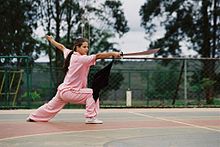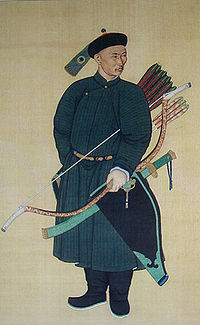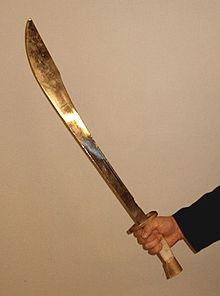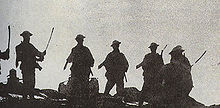- Dao (sword)
-
Dao (sword) Traditional Chinese 刀 Transcriptions Mandarin - Hanyu Pinyin dāo - Wade–Giles tao1 Cantonese (Yue) - Yale Romanization dou1 Dao (Chinese: 刀; pinyin: dāo; Wade–Giles: tao1, "knife") is a category of single-edge Chinese swords primarily used for slashing and chopping (sabers), often called a broadsword in English translation because some varieties have wide blades. In China, the dao is known as one of the four major weapons, along with the gun (staff), qiang (spear), and the jian (sword), and referred to as "The General of All Weapons". Dao is actually a generic word used to denote any member of a family of single-edged, broad-bladed cutting or slicing tools, but in common, everyday usage means knife. The weapon, also known as dan dao 單刀 (single knife) when just one is used, is thereby thought to be an adaptation of the kitchen knives common to Chinese cuisine. Dao also appears in the names of such polearms as the pudao and guan dao, due to the knife-like shape of their blades.
Contents
General characteristics
While dao have varied greatly over the centuries, most single-handed dao of the Ming period and later, and the modern swords that are based (sometimes loosely) on them share a number of characteristics. Dao blades are moderately curved and single-edged, though often with few inches of the back edge sharpened as well; the moderate curve allows them to be reasonably effective in the thrust. Hilts are sometimes canted, curving in the opposite direction as the blade which improves handling in some forms of cuts and thrusts. Cord is usually wrapped over the wood of the handle. Hilts may also be pierced like those of jian (straight-bladed Chinese sword) for the addition of lanyards, though modern swords for performances will often have tassels or scarves instead. Guards are typically disc-shaped often with a cupped shape to prevent rainwater from getting into the sheath, and to prevent blood from dripping down to the handle, making it more difficult to grip. Sometimes guards are thinner pieces of metal with an s-curve, the lower limb of the curve protecting the user's knuckles; very rarely they may have guards like those of the jian.
Other variations to the basic pattern include the large bagua dao and the long handled pudao.
 Dao as seen in modern wushu.
Dao as seen in modern wushu.
Early history
The earliest dao date from the Shang Dynasty in China's Bronze Age, and are known as zhibei dao (直背刀) - straight backed knives. As the name implies, these were straight-bladed or slightly curved weapons with a single edge. Originally bronze, these weapons were made of iron or steel by the time of the late Warring States period as metallurgical knowledge became sufficiently advanced to control the carbon content. It is also speculated that iron swords existed before this time, but were simply not preserved. Originally less common as a military weapon than the jian - the straight, double-edged blade of China - the dao became popular with cavalry during the Han dynasty due to its sturdiness, superiority as a chopping weapon, and relative ease of use - it was generally said that it takes a week to attain competence with a dao/saber, a month to attain competence with a qiang/spear, and a year to attain competence with a jian/straight sword. Soon after dao began to be issued to infantry, beginning the replacement of the jian as a standard-issue weapon.[1][2]
During the Tang Dynasty, dao were exported to both Korea and Japan, influencing the swordsmithing of both nations.[3] The blades of Tang era dao are reminiscent of the Japanese chokuto or the popular image of the perhaps-mythical ninjato.
During the Song Dynasty, one form of infantry dao was the shoudao, a chopping weapon with a clip point. While some illustrations show them as straight, the 11th century Song military encyclopedia Wujing Zongyao depicts them with curved blades - possibly an influence from the steppe tribes of Central Asia, who would conquer parts of China during the Song period. Also dating from the Song are the falchion-like dadao,[4] the long, two-handed zhanmadao,[5] and the long-handled, similarly two-handed buzhandao (步战刀).
Yuan, Ming and Qing
 One of the Qianlong Emperor's Imperial Guards Brigade (1760) carrying his archery equipment and wearing a sheathed dao. Notice the lanyard through the handle.
One of the Qianlong Emperor's Imperial Guards Brigade (1760) carrying his archery equipment and wearing a sheathed dao. Notice the lanyard through the handle.
The Mongols invaded China in the early 13th century. The Mongolian Yuan dynasty influenced China and other nations considerably, particularly in the tools and tactics of war. A favored weapon of the Mongol cavalry was the saber: this simple, one handed, curved blade had been used by the Turkic and Tungusic tribes of Central Asia since probably at least the 6th century.[6][7] Its effectiveness for mounted warfare and popularity among soldiers across the entirety of the Mongol empire had lasting effects. The Persian shamshir, the Indian talwar, the Afghani pulwar, the Turkish kilij, the Arabian saif (all of which can be referred to by the blanket-term "scimitar") and the European saber (adopted via Hungary's Magyar horsemen) and cutlass are perhaps descended from the Turko-Mongol curved blade.[7][8]
In China, Mongol influence lasted long after the collapse of the Yuan dynasty at the hands of the Ming, continuing through both the Ming and the Qing dynasties (the latter itself founded by a steppe people, the Manchu), furthering the popularity of the dao and spawning a variety of new blades. Blades with greater curvature became popular, and these new styles are collectively referred to as pei dao. During the mid-Ming these new sabers would completely replace the jian as a military-issue weapon.[9] The four main types of pei dao are:[10][11]
- yanmao dao, or "goose-quill saber." This weapon, similar to the earlier zhibei dao, is largely straight, with a curve appearing at the center of percussion near the blade's tip. This allows for thrusting attacks and overall handling similar to that of the jian, while still preserving much of the dao's strengths in cutting and slashing.[12]
- liuye dao, the "willow leaf saber." The most common form of Chinese saber, this weapon features a moderate curve along the length of the blade. This weapon became the standard sidearm for both cavalry and infantry, and is the sort of saber originally used by many schools of Chinese martial arts.[13]
- pian dao, "slashing saber." A deeply curved dao meant for slashing and draw-cutting, this weapon bears a strong resemblance to the shamshir and scimitar. A fairly uncommon weapon, it was generally used by skirmishers in conjunction with a shield.[14]
- niuweidao, the "oxtail saber." A heavy bladed weapon with a characteristic flaring tip, this is the archetypal "Chinese broadsword" of kung fu movies today. It is first recorded in the early 19th century (the latter half of the Qing dynasty) and only as a civilian weapon: there is no record of it being issued to troops, and it does not appear in any listing of official weaponry. Its appearance in movies and modern literature is thus often anachronistic.[10][15]
Besides these four major types of dao, the duan dao or "short dao" was also used, this being a compact weapon generally in the shape of a liuye dao.[16] The dadao saw continued use, and during the Ming dynasty the large two-handed changdao and zhanmadao were used both against the cavalry of the northern steppes and the wokou (pirates) of the southeast coast; these latter weapons (sometimes under different names) would continue to see limited use during the Qing period.[17] Also during the Qing there appear weapons such as the nandao, regional variants in name or shape of some of the above dao, and more obscure variants such as the "nine ringed broadsword," these last likely invented for street demonstrations and theatrical performances rather than for use as weapons.
The Chinese spear and dao (liuyedao and yanmaodao) were commonly issued to infantry due to the expense of and relatively greater amount of training required for the effective use of Chinese straight sword, or jian. Dao can often be seen depicted in period artwork worn by officers and infantry.
During the Yuan dynasty and after, some aesthetic features of Persian, Indian, and Turkish swords would appear on dao. These could include intricate carvings on the blade and "rolling pearls": small metal balls that would roll along fuller-like grooves in the blade.[18]
Recent history
Some of the blades from the Qing Dynasty lived on and even had descendants see military action in the 20th century. The dadao was used by some Chinese militia units against Japanese invaders in the Second Sino-Japanese War, as was the miao dao, a descendant of the changdao. These were used during planned ambushes on Japanese troops because the Chinese military and patriotic resistance groups often had more willing soldiers than firearms.[citation needed]
Most Chinese martial arts schools still train extensively with the dao, seeing it as a powerful conditioning tool and a versatile weapon, with self defense techniques transferable to similarly sized objects more commonly found in the modern world, such as canes, baseball or cricket bats, for example. There are also schools that teach double broadsword shuang dao 雙刀, forms and fencing, one dao for each hand.[citation needed]
One measure of the proper length of the sword should be from the hilt in your hand and the tip of the blade at the brow and in some schools, the height of shoulder. Alternatively, the length of the sword should be from the middle of the throat along the length of the outstretched arm. There are also significantly larger versions of dao used for training in some Baguazhang and Taijiquan schools.[citation needed]
See also
Notes
- ^ Tom 2001, p.207
- ^ Graff 2002, p.41
- ^ Grancsay 1930, p.194
- ^ Tom 2005, p. 84
- ^ Hanson
- ^ http://medieval2.heavengames.com/m2tw/history/miscellaneous_history_folder/mongol_weapons/index.shtml
- ^ a b http://www.arscives.com/gallery/en/fireandforge/development.htm
- ^ [1]
- ^ Tom 2001, pp. 207-209
- ^ a b Tom 2001, p. 211
- ^ Tom 2005, p. 76
- ^ Tom 2005, p. 77
- ^ Tom 2005, pp. 77-78
- ^ Tom 2005, p. 78
- ^ Tom 2005, p. 78-79
- ^ Tom 2005, pp. 80, 84
- ^ Tom 2005, p.85
- ^ Tom 2001, pp. 209, 218
References
- Graff, David A. (2002). Medieval Chinese Warfare, 300-900. London: Routledge. ISBN 0-415-23955-9.
- Grancsay, Stephen (1930). "Two Chinese Swords". The Metropolitan Museum of Art Bulletin, Vol. 25, No. 9, pp. 194–196
- Hanson, Chris. "The Mongol Siege of Xiangyang". http://www.deremilitari.org/resources/articles/hanson.htm. Retrieved 6 September 2009.
- Tom, Philip M. W. (2001). "Some Notable Sabers of the Qing Dynasty at the Metropolitan Museum of Art". Metropolitan Museum Journal, Vol. 36, pp. 11 + 207-222
- Tom, Philip with Scott M. Rodell (February 2005). "An Introduction to Chinese Single-Edged Hilt Weapons (Dao) and Their Use in the Ming and Qing Dynasties". Kung Fu Tai Chi, pp. 76–85
- Werner, E. T. C. (1989). Chinese Weapons. Singapore: Graham Brash. ISBN 9971-4-9116-8.
Types of Chinese weapons Short Swords Long Swords Polearms Guandao 關刀 · Ge (Dagger-Axe) 戈 · Gun 棍 · Ji 戟 · Nangun 南棍 · Podao 朴刀 · Qiang 槍 · Hongyingqiang 紅纓槍 · Yueya Chan (Monk's Spade) 月牙鏟Roped/Chained Liuxing Chui (Meteor Hammer) 流星錘 · Sheng Biao (Rope Dart) 繩鏢 · Jiujie bian (nine section whip) 九節鞭 · Sanjie Gun 三節棍 · Shuangjie Gun 雙節棍Projectile Handheld Chui 錘 · Emeici 峨嵋刺 · Lujiao Dao (Deer Horn Knives) 鹿角刀 · Hook Sword 鉤 · Ji Lian 鷄鐮 · Fenghuo Lun 風火輪Categories:- Chinese mêlée weapons
- Chinese swords
- Chinese swordsmanship
- Single-edged swords
- Traditional Chinese objects
Wikimedia Foundation. 2010.


